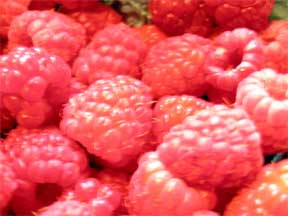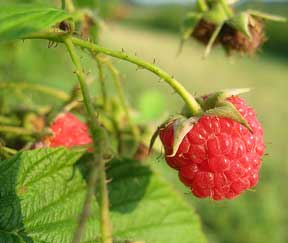Red Raspberries fresh from the garden? Home made blackberry jam? Blueberry muffins? Gooseberry pie? All of these sound tempting, exciting and very challenging to the amateur fruit grower.
In our enthusiastic imaginations we can see them flourishing in our gardens. We anticipate the end products with mouth watering joy. This winter as we are study pictures in the nursery catalogs and on the web… we ask. Can we actually grow these fine fruits in our gardens?
In some cases – yes, in other cases perhaps, and unfortunately, in some instances – no. Our grandparents without the so-called advances in scientific spraying, fertilization, disease control, improved varieties, etc., actually did a much better job with many of these fruits than we can hope to do with our present equipment and knowledge. Their advantages were a new country, isolation from sources of infections, virgin soils and plants free of insects and diseases.

Since their day we have introduced into our areas, insects and diseases that did not exist here a half century ago. We live more closely to our neighbors and they share their disease and insect troubles with us.
In spite of rigid inspections, our nursery stock may carry hidden diseases like viruses. Our soils have lost their virgin fertility and may be infested with nematode and other soil borne troubles. We may also in our enthusiasm attempt to grow berries that even our grandparents could not grow because of climatic and soil conditions in our locale.
It, therefore, becomes at least practical to recognize our difficulties and practice our green thumb talents where our chances of success are best.
Some Are Impractical
Blueberries are a good example of a most delicious fruit. not adapted generally to the Midwest. They require abundant moisture, a cool, acid, fertile soil and moderate temperatures. Even after we correct the soil acidity to the liking of the blueberry plant, the dry hot winds and high temperatures usually prove too much of a handicap for even moderate production.
Western trailing blackberries like the boysenberry and loganberry, are too tender for most Midwestern areas and usually succumb in a year or two to frost or disease, or both.
Of the berries our grandparents raised successfully, one is most outstanding in its ease of growing. That one is the gooseberry. Give it a fertile soil, a little protection from the southwest hot wind and sun, spray it for leaf eating insects, and you will have gooseberries for pies and sauce, especially if you secure the best varieties.
This variety is very hardy, very productive, and derives its name from the long fruit stems which permit easy picking, without the usual number of thorns.
The Hardy Gooseberry
The writer has seen many shrubs growing on the east side of the house that were no more ornamental than a gooseberry bush. The preferred location for the many bushes, however, would be along the north or east side of a fence if such location is available.
Three or four bushes will give a good family supply for seasonal use and for storing for the future. The most popular of our the Midwestern berries is perhaps the raspberry which at one time was grown quite successfully throughout the Midwest.
In spite of fairly good spray programs and the best cultural methods, the results are frequently quite disappointing. It is probably a case of scientific advances not keeping pace with our problems.
Many of us think that virus diseases, known and unknown, along with probable nematode infestations, result in a lower vitality that greatly reduces both productivity and the length of the plant’s productive life.
Difficulties with Raspberries
We have developed spray programs that fairly well control the most obvious diseases, a mulch program that reduces soil temperatures and prevents serious drought injury, and a fertilization program that apparently provides for the nutritional requirements.

In spite of these advances the production and life of the plants are quite short, usually only two to four years. The writer was raised on a Midwestern berry farm where a black raspberry planting remained in good productivity for ten or more years, but that was four decades ago under a situation that does not exist today.
There are three distinct types of raspberries, namely reds, blacks, and purples.
The black raspberry is most common in the Midwest and like all raspberries, thrives best in the more northern areas.
The red raspberries are usually a little more difficult to grow as they are more sensitive to unfavorable weather, but, of course, have a distinctive, desirable flavor.
The purple raspberries are really hybrids, crosses of red and black varieties, and usually carry much hybrid vigor, a very desirable quality. Their growth habit is like the black raspberry, but the flavor is more acid than either the black or the red.
All of the raspberries need a fertile, well-drained soil with plenty of organic matter. The best practice by far is to grow them under a heavy mulch, the mulch being heavy enough to prevent weed growth and entirely taking the place of cultivation. The mulch should be renewed each year and nitrogen fertilizers added to prevent the mulch from causing nitrogen starvation.
Pruning
A good spray program is almost always a must with raspberries as is proper pruning. A trellis or stakes to support the plants is desirable, but not necessary. With a trellis, a higher production is possible, especially during the first seasons and of course, the berries will be supported above the ground.
All raspberries have biennial canes which grow one season, fruit the next season, then die. It is desirable to pinch the tops out of the new canes of the black and purple varieties when they reach a height of 24 to 30 inches, causing a branched fruiting cane for the next season. It is a mistake, however, to do this to the red varieties.
The old fruiting wood is best removed immediately after harvest. Spring pruning consists of removing weak and dead wood and reducing the length of the fruiting canes to just what the plant can support.
The new plants of black and purple raspberries are formed by the tips of the canes taking root in late summer. New plants of red raspberries and upright blackberries are sucker plants from the roots.
Blackberries are found naturally throughout most Midwestern states and these wild fruits furnish many families with adequate supplies. Named varieties were, until about 50 years ago, considered one of the easiest fruits to grow for family use.
Like raspberries, blackberries also produce better under mulch rather than cultivation because of its efficiency in retaining moisture, reducing soil temperatures and preventing weed growth.
The Other Blackberries
The trailing types of blackberries are referred to by various names. The eastern type is usually called a dewberry while the western types are given specific names like Loganberry, Beysenberry, Yeungberry, etc.
Both types are rather difficult to grow in the Midwest because of their extreme tenderness and susceptibility to diseases. Dewberries are the more hardy of these types, but they too usually require protection from winter temperatures and spring frosts.
Boysenberries are perhaps the choice of the western types, but they are extremely tender and very susceptible to bramble diseases.
A few people have “beginners luck” with a few plants for one or two crops, but after that, The rigorous midwest climate and disease usually take complete control.
The amateur can well start with vegetables because of their short season and limited space requirements, progress to strawberries, and then try his horticultural skill with some of the berry fruits adapted to the Midwest such as gooseberries, raspberries, and “Early Harvest” blackberries.
These have advantages over tree fruits which require more space and exacting spraying of large plants with equipment unavailable to most of us.
Contributed by WR Martin
